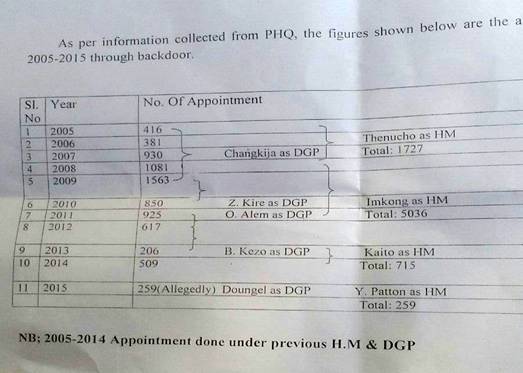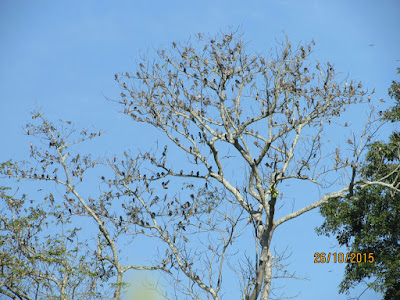While the state of Nagaland is experiencing a decrease in
the farming population ‘there is increase in productivity due to technological
intervention,’ a local administrator of Dimapur said on Tuesday. The official,
Deputy Commissioner of Dimapur Kesonyu Yhome, said the decrease in the farming
population is one of the reason ‘for which we import paddy from other states.’
Yhome was addressing a gathering of farmers during an event recently.
An agricultural event called the ‘Farmers’ Field Day’, organized under the National Food Security Mission was conducted by the District Agriculture Office of Dimapur in Singrijan village on November 17.
The deputy commissioner of Dimapur, Kesonyu Yhome, attended the event as the guest of honor. In his speech, Yhome exhorted the farming community of Singrijan village to follow and adopt new farming techniques taught to them by the Agriculture department. That way, he said, the farmers can ‘achieve higher yield’ in agricultural production.
He reminded that the forefathers of the Naga people had ‘no luxuries of life in the past, yet survived through their hard work.’ Observing that although there had been a decrease in the farming population in every corner of the world, ‘there is increase in productivity due to technological intervention,’ the administrator told the gathering.
"In our state the farming population is decreasing so also the productivity of yield and for which we import paddy from other states", he regretted. Yhome asked the gathering of farmers to ponder on the issue.
Further, he asked the gathering to take full advantage of the many logistic supports extended to them by the Agriculture department and to work in unity as far as agriculture activity is concerned so as to raise their standard of living. "The better you perform, the more support from the government will be given", he maintained.
Delivering the keynote address, the deputy director of the Agriculture department, Sosangmar termed Farmers’ Field Day as a special occasion for the farming community where ‘experiences and difficulties could be shared.’
"Without the Field Day, the mandate of NFSN will not be successful', he remarked. When farmers show interest, it becomes an integrated approach because all the agriculture and allied departments step forward to help, he asserted. He called ‘dynamism of farmers’ as a key factor toward paving ‘many other ways for the benefit of farming community.’ "Nagaland is self sufficient in all other food grains besides paddy where there is deficit of 33%", Sosangmar said.
Further reminding that food security as the ‘vision’ of the Agriculture department, he said, "We cannot increase the land but can work towards higher yield to fulfill our vision with technological intervention."
The APP of Dimapur, L Mongsanger, who gave a brief report about the National Food Security Mission said that the program had made significant progress in Dimapur district in terms of production and productivity of rice, acceptance and adoption of new production technologies and also new implements and machineries.
He also informed that under Dimapur district, the National Food Security Mission was being implemented in 35 clusters covering four blocks. Mongsanger was of the view that the program had contributed significantly in accelerating food grains production in the district. He mentioned that Singrijan village was one of the best-performing villages and for which Farmers Field Day was being conducted in the village.
A progressive farmer from Singrijan village, Tik Bahadur, spoke during the event. While sharing his experiences with the National Food Security Mission, Bahadur said that the traditional methods of farming and farming with technological intervention had vast differences in terms of productivity. The farmer said that with the application of line transplanting techniques his yield of paddy during the previous year cultivated in one bigha was 1, 200 kilograms. However, he said, cultivating the same area ‘with traditional modes of farming,’ the yield was 720 kilograms only.
Another progressive farmer from Shozukhu village, Hotoshe Sumi, lauded the Agriculture department for training the farmers and for providing logistic support to the farming community.
During the event, agriculture officer Ronchamo Kikon gave a
review of yield. He said that crop cutting experiments were a regular feature
for specific crops, ‘to observe the efficacy and supremacy of line
transplantation and also to assess yield per hectare.’
In the second session, agriculture officer Rokovotsole demonstrated seeds treatment for winter crops and another agriculture officer Wochamo distributed winter crop seeds, micro nutrients, and bio-fertilizers to the farmers.
National Food Security Mission
National Food Security Mission is a Central Scheme of the government of India that was launched in 2007 for 5 years to increase production and productivity of wheat, rice and pulses on a sustainable basis so as to ensure food security of the country.
The aim is to bridge the yield gap in respect of these crops through dissemination of improved technologies and farm management practices.
Current Status
The targets of 11th five year exceeded and it was extended to 12th five year plan in 2012. In the 12th Plan, NFSM aims at raising the food grain production by 25 million tones. Besides rice, wheat and pulses, NFSM proposes to cover coarse cereals and fodder crops during the 12th plan period (2012-17). 11th plan covered 15 states under NFSM-Rice, 9 states under NFSM-Wheat and 16 States under NFSM Wheat.
Hence, all states were not covered during 11th plan for NFSM. 12th plan aims to cover all the states of India with focus on low productive areas to bridge the yield gaps for additional production while stability in high production areas would be achieved through promotion of conservation agriculture practices.
Central government allocated over Rs 1,800 crore to states under the National Food Security Mission (NFSM) in 2012 to raise food grains output by 25 million tones in the 12th Five Year Plan period as the mission was extended with beyond expected output during XI the five year plan. Uttar Pradesh got the maximum amount at Rs 276.9 crore, followed by Madhya Pradesh Rs 226.87 crore and Maharashtra Rs 196 crore.
(Al Ngullie)


